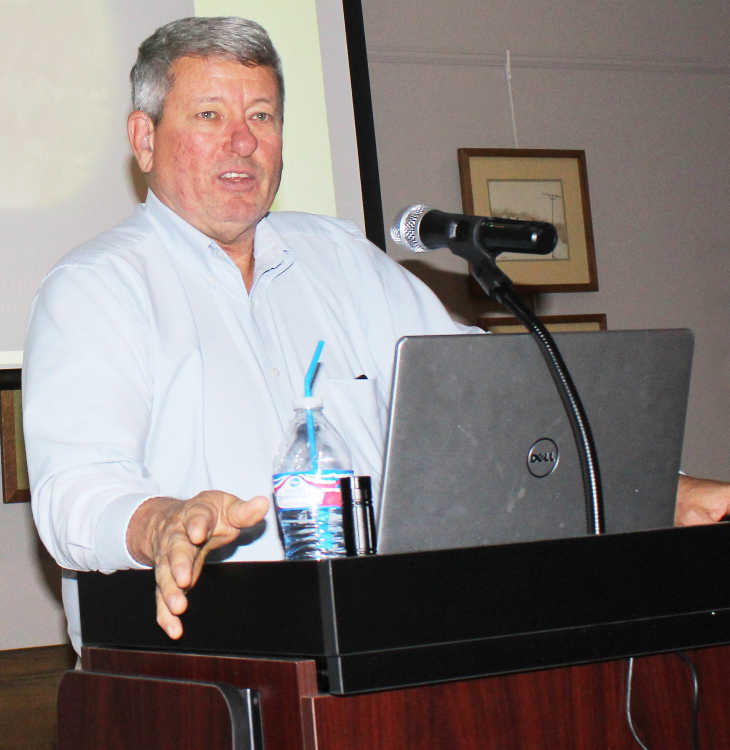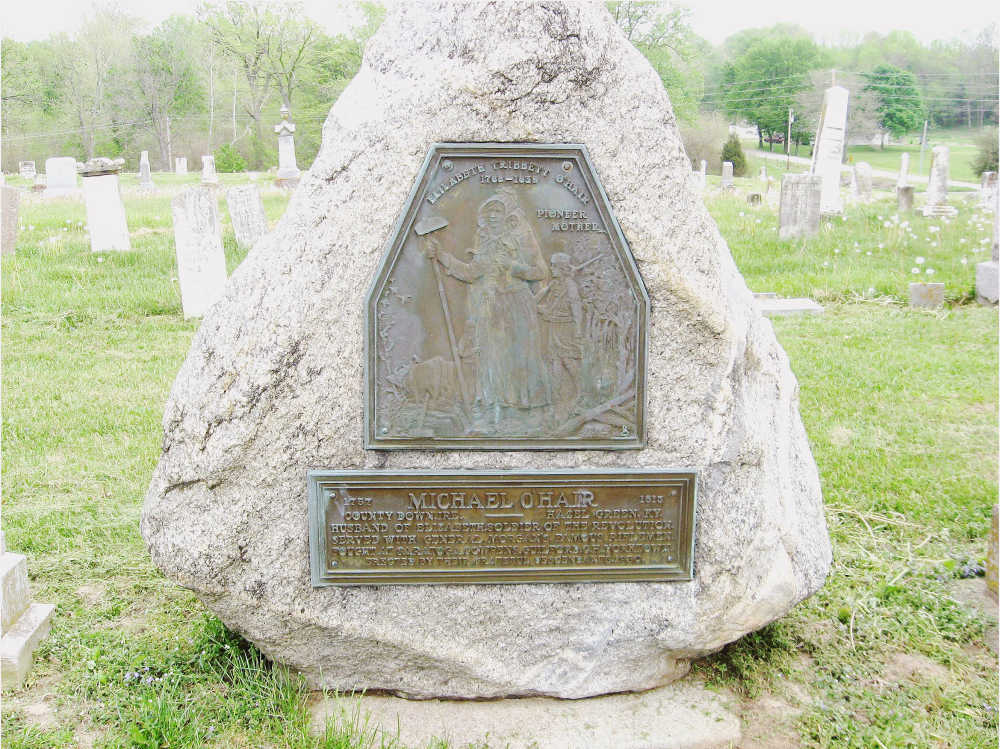Tippin details Pleasant Garden, Reelsville, Brick Chapel and ‘County That Almost Was’

Larry Tippin turned myth buster during the latest installment of the Tiny Towns and Vanished Villages series he’s been presenting monthly at the Putnam County Museum.
After four months of sharing secrets and fascinating facts about some of hamlets and one-horse towns that once populated the Putnam countryside, Tippin tackled the Pleasant Garden-Reelsville “tug-of-war,” along the way putting to rest a long-held notion of how Pleasant Garden got its name.
The Washington Township pair of Reelsville and Pleasant Garden, Putnam County Historian Tippin told an audience in excess of 40 Thursday night, are “two separate communities, platted out separately.”

Reelsville was probably first settled by John and Mary Reel in 1826, Tippin said, although for some unknown reason the Reels did not file a plat for Reelsville until Jan. 5, 1852.
Pleasant Garden, meanwhile, was platted Jan. 20, 1830 by John Matkins and John W. Witty.
What makes that 1830 date so significant is that it essentially dismisses the theory that President Abraham Lincoln was responsible for naming Pleasant Garden.
That old story notes that where the old Holsapple Grocery was located in 1960s, there was once a two-story log inn with a grocery store and eating place below and the guest rooms above.
“There are two interesting stories associated with this inn,” Tippin related, noting that in back of it was a very beautiful garden, while in front of it ran the old National Road with its 80-foot right of way for the oxen to graze upon as settlers moved westward along the highway.
The old story is that Abraham Lincoln once spent the night at the inn.
“As usual, he arose early and took a stroll in the lovely garden,” Tippin related.
“At breakfast,” he added, “Mr. Lincoln was reported to have told the lady who owned the inn, ‘You have a very pleasant garden,’” and supposedly hence came the name.
But local lore has played fast and loose with the facts, Tippin suggested.
“In 1829 (the year before Pleasant Garden was platted with that name), Lincoln was a gangly rail splitter,” Tippin said of the man who wouldn’t be president for another 32 years. “I’m not seeing that (as a true story).”
So it wasn’t named by Abe. Honest.
Stories nonetheless have presisted that Lincoln spent the night in Manhattan and also at Rising Hall on the Putnam-Hendricks line when the Italianate home was owned by Melville F. McHaffie. He reportedly sold mules to the Union Army and was said to have hosted Lincoln during his travels along the National Road.
“Abraham Lincoln apparently slept in every single town on the National Road,” Tippin joked.
Regarding what he referred to as the Reelsville-Pleasant Garden “tug-of-war,” Tippin said it “wasn’t meant to be a negative thing.”
First Pleasant Garden “had supremacy,” he said, because it was on the National Road, which wasn’t even a gravel road until 1833. “Thus, the National Road was not the well-traveled route we might think of it to be until that time,” Tippin noted.
Reelsville, however, went on top when the Indianapolis and Terre Haute Railroad went through in 1852.
Then in 1875 the bridge over Big Walnut Creek west of Pleasant Garden was washed out and the National Road relocated. But in 1922 a new bridge erected over Big Walnut, so the traffic was again bypassing Reelsville instead down the center of Pleasant Garden.
In 1940, it became U.S. 40 and moved south of the National Road and south of Pleasant Garden, much to the dismay of local businessman Dewey Osborne, who operated the Truckers Haven truck stop at Pleasant Garden. Once known as the busiest place to stop and get gasoline between Indianapolis and Terre Haute, the truck stop reportedly went out of business a short time later due to the highway’s relocation.
So, the two villages are now, for all practical purposes, one. The Reelsville Fire Department, school building, sawmill etc., are all in Pleasant Garden.
Pleasant Garden, by the way, is “never plural, just one garden,” Tippin stressed, bristling after showing the slide of a more recent map incorrectly listing it as “Pleasant Gardens.”
Meanwhile, Tippin also shared how Montgomery Chapel evolved into Brick Chapel, five miles north of Greencastle. It was named initially, he said, because of the preponderance of area settlers who had come to Putnam County from Montgomery County, Ky.
However, Montgomery Chapel and the cemetery came to be known as Brick Chapel in 1872 when the current brick church was built. Brick Chapel had a post office from April 1873-1905, Tippin noted.
Burials began at the adjoining cemetery in 1839 and are ongoing with more than 2,000 interred there. Those include a War of 1812 veteran, John Falls Sr., 14 Civil War veterans, four from the Spanish-American war and others from additional conflicts.
Near the north side of the church at the edge of the cemetery stands a marker commemorating early area pioneers Elizabeth Tribbett O’Hair, 1768-1839, and husband Michael O’Hair, a Revolutionary War veteran, 1757-1813.
Tippin moved on to detail how Russellville was founded in 1829 -- the first platted town other than Greencastle in Putnam County -- and then briefly became Darter after William Darter became postmaster in 1882.
By 1885, however, William Long had been appointed postmaster and town residents petitioned to have the name Russellville restored, which was granted Sept. 3, 1885.
The Indianapolis, Decatur and Springfield railroad (later the Indianapolis, Decatur and Western, then the B & O) came through Russell Township in 1880, missing Russellville by about a half-mile to the south. The town then grew in that direction as several new businesses sprung up along and near the new railroad shortly after it came through.
“By 1910, Rusellvillle became so prominent,” Tippin said, that it had such businesses as a flour mill, two sawmills, a grain elevator, a lumberyard, two hardware stores, three general stores, a grocery, two restaurants, three barbershops, a furniture and undertaking establishment, a meat market, a drugstore, a millinery store, a shoe store, a blacksmith shop, three physicians, a weekly newspaper and the Russellville State Bank had been formed.
In 1920, the town reached its high-water mark in population with 463 residents. In 2010, meanwhile, the Census listed 358 people as calling Russellville home.
The Russellville-Darter talk yielded to Tippin’s final sojourn into “The County That Almost Was.” That involved a desire by some community residents to create a new county called Bourbon to be comprised of equal parts of the northwest quarter of Putnam, southwest quarter of Montgomery and part of eastern Parke County.
When Russellville was platted, Tippin noted, a public square was even set aside at the southeast corner of Harrison and Morgan streets for the county seat.
In 1859, a bill passed the State Legislature, he said, calling for the creation of the new county “provided, however that the commissioners of Putnam, Parke and Montgomery counties agreed to such organization.”
The proposal lost by just one vote as a Parke County representative named Cain was opposed to the idea, believing it was not in the best interest of his county to cede so much land to the proposed new county.
But the idea was not laid to rest immediately.
In 1861, the issue was again brought before the legislature. But the Senate would not amend House Bill 39 relating to formation of new counties to include the proposed formation of Bourbon.
Thus, the matter of a new county being created was settled, resulting in Russellville and the surrounding area forevermore remaining part of Putnam County, Tippin concluded.
More Putnam County tiny town talk is slated for Thursday, May 23 when Tippin’s 6:30 p.m. presentation at the Putnam County Museum will cover the Clinton Falls-Grubb’s Mill-Alma area, the Blakesburg-Cairo-Fincastle area and Manhattan.
